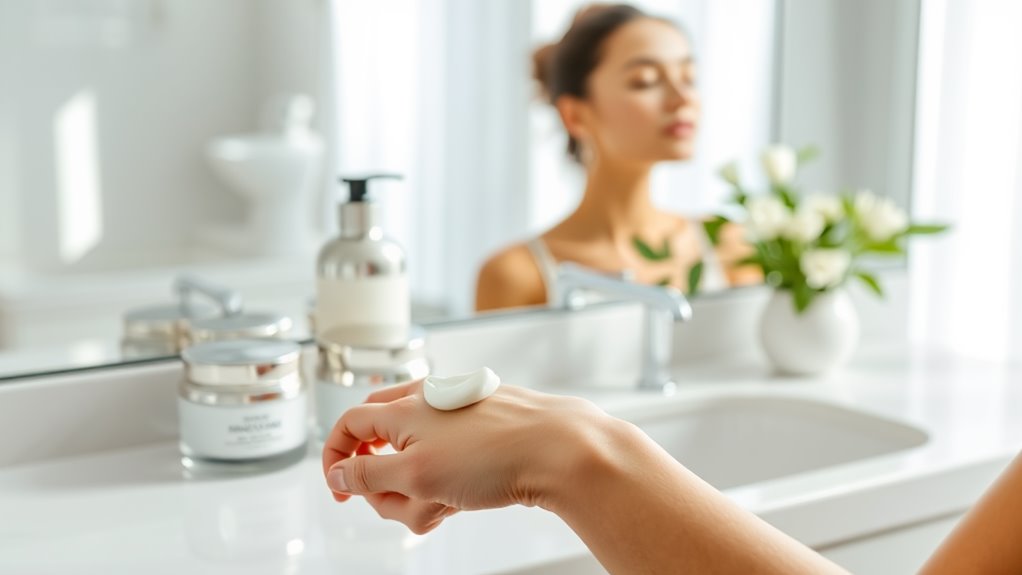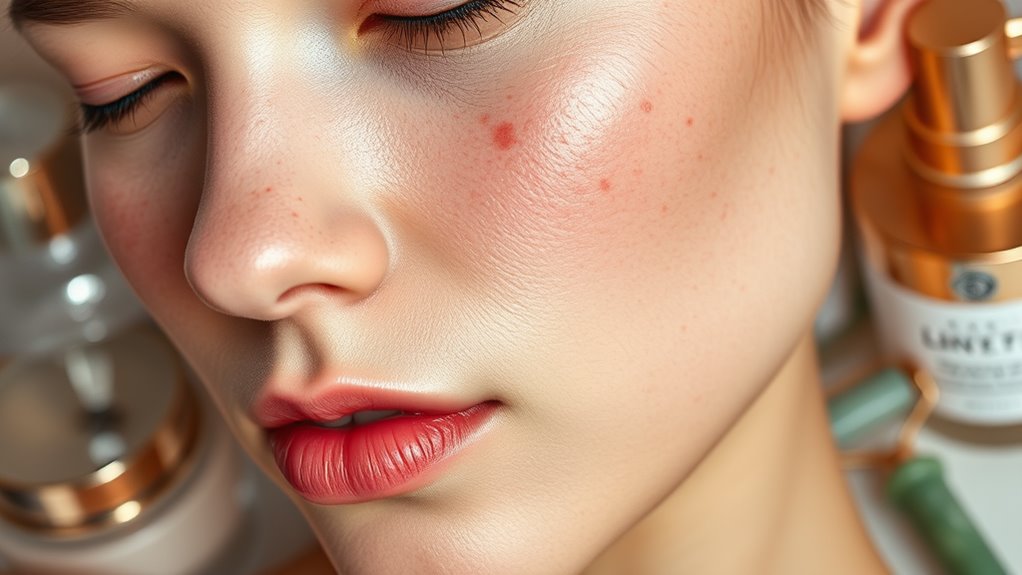The One Ingredient That Works for Both Acne and Aging
Retinol is the key ingredient that effectively fights both acne and signs of aging. It promotes cell turnover, unclogs pores, and reduces inflammation, making it perfect for acne treatment. Simultaneously, it stimulates collagen production, improves skin texture, and combats fine lines, ensuring a youthful appearance. Start with a low concentration to minimize irritation and always apply it at night. By incorporating this powerhouse into your routine, you’ll experience smoother, firmer skin, and there’s more to discover about its benefits.
Key Takeaways
- Retinol is a powerful vitamin A derivative that promotes cell turnover, benefiting both acne-prone and aging skin.
- It unclogs pores and reduces inflammation, effectively treating acne while also minimizing fine lines and wrinkles.
- Retinol enhances collagen production, improving skin elasticity and firmness, addressing both signs of aging and acne scars.
- Regular use of retinol leads to improved skin texture and tone, making it suitable for those with hyperpigmentation from acne or aging.
- Incorporating retinol into your routine requires caution to minimize irritation, especially when treating both conditions simultaneously.
Understanding Retinol: The Power of Vitamin A
When it comes to skincare, understanding retinol is crucial, especially since this powerful derivative of vitamin A has proven benefits for both acne and aging.
Retinol promotes cell turnover, revealing fresher skin and enhancing collagen production, which is vital for maintaining skin elasticity. By stimulating new cell growth, it helps in reducing fine lines and improving skin texture.
Additionally, retinol can minimize hyperpigmentation, giving your complexion a more even tone. These retinol skincare benefits make it an essential component in anti-aging regimens and acne treatments alike. Recent studies have shown that retinol effectively addresses both acne and the signs of aging, further solidifying its importance in skincare.
When incorporating retinol into your routine, start with a lower concentration to assess tolerance and gradually increase usage for optimal results.
Mastering retinol can significantly elevate your skincare game.
How Retinol Fights Acne
Although many factors contribute to acne, retinol effectively addresses several of them by promoting skin renewal and unclogging pores.
By accelerating cell turnover, retinol helps prevent dead skin from blocking pores, reducing the likelihood of breakouts.
Here’s how retinol combats acne:
-
Enhances Cell Turnover: Promotes faster shedding of dead skin cells.
-
Unclogs Pores: Prevents buildup of sebum and debris within follicles.
-
Reduces Inflammation: Alleviates redness and swelling associated with acne lesions.
-
Minimizes Hyperpigmentation: Helps fade post-acne marks by speeding up healing.
Incorporating retinol into your skincare routine can provide significant benefits, allowing you to achieve clearer, healthier skin while effectively tackling the root causes of acne. Additionally, combining retinol with salicylic acid benefits can further enhance the treatment of acne-prone skin.
The Anti-Aging Benefits of Retinol
As you age, the skin’s natural processes slow down, leading to wrinkles, fine lines, and a loss of elasticity.
Retinol, a derivative of vitamin A, effectively combats these signs of aging. It stimulates collagen production, enhancing skin firmness and reducing the appearance of wrinkles.
By promoting cell turnover, retinol helps to shed dead skin cells, revealing a more youthful complexion beneath. Additionally, retinol improves skin texture and tone, addressing uneven pigmentation and dullness.
The antioxidant properties of retinol protect against free radical damage, further preserving skin vitality. Studies have shown that retinol can significantly improve the overall appearance of aging skin.
Consistent use can result in visibly smoother, firmer skin, making retinol an essential component in your anti-aging arsenal. Understanding its mechanisms empowers you to achieve lasting results in your skincare routine.
Incorporating Retinol Into Your Skincare Routine
To effectively incorporate retinol into your skincare routine, start by selecting a product with a concentration suited for your skin type and tolerance.
Follow these steps to maximize its benefits:
-
Patch Test: Apply a small amount on your wrist to check for any adverse reactions.
-
Start Slow: Begin with a low concentration, applying it once or twice a week to allow your skin to adjust.
-
Night Use: Apply retinol at night, as it can increase sun sensitivity. Always follow with a broad-spectrum sunscreen during the day.
-
Moisturize: Layer a moisturizer over retinol to combat dryness and enhance absorption. Additionally, retinol is known for its ability to unlock youthful skin by promoting cell turnover and reducing fine lines.
Potential Side Effects and Precautions
While incorporating retinol into your skincare routine can yield significant benefits for acne and aging, it’s important to be aware of potential side effects and precautions.
Common side effects include skin irritation, dryness, peeling, and increased sensitivity to sun exposure. To minimize these effects, start with a lower concentration and gradually increase usage.
It’s crucial to apply sunscreen daily, as retinol can heighten your skin’s vulnerability to UV damage. If you’re pregnant or breastfeeding, consult a healthcare professional before using retinol, as it may not be safe.
Additionally, avoid combining retinol with other potent active ingredients like AHAs or BHAs, as this can exacerbate irritation. Over-exfoliating can also lead to barrier damage and worsen these side effects.
Proper understanding and careful application can optimize your experience with retinol.
Choosing the Right Retinol Product for Your Skin
Selecting the right retinol product for your skin is essential for maximizing its benefits and minimizing potential side effects. To ensure you choose wisely, consider the following factors:
-
Concentration: Start with a lower concentration (0.25%-0.5%) to assess tolerance, then gradually increase as needed.
-
Formulation: Look for products with additional soothing ingredients like hyaluronic acid or niacinamide to mitigate irritation.
-
Delivery System: Opt for encapsulated retinol or time-released formulations, which can enhance efficacy while reducing irritation.
-
Skin Type: Tailor your choice based on your skin type—dry, oily, or sensitive—since each may respond differently to retinol.




